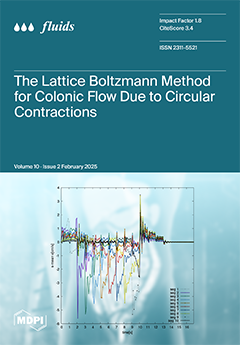A numerical simulation of the circular cylinder as an obstacle in a double forward-facing (DFFS) step was performed. The size and position of the upstream cylinder (
c1) and downstream cylinder (
c2) were varied to explore their role
[...] Read more.
A numerical simulation of the circular cylinder as an obstacle in a double forward-facing (DFFS) step was performed. The size and position of the upstream cylinder (
c1) and downstream cylinder (
c2) were varied to explore their role in heat transfer in both laminar and turbulent conditions. Comparative results of the upper and lower half of the downstream cylinder were plotted as results to understand the heat transfer and flow characteristics around the downstream cylinder due to the effect of the upstream cylinder’s dimension and position. For
Re = 800, when the
c1 is placed near the bottom of the wall, it results in a pair of rear-side symmetrical vortices, and the
c2 cylinder vortices become larger when the
c1 is shifted towards the top wall. Additional flow separation happens adjacent to the steps when
c1 is greater than
c2. These vortices strongly influence the convection heat transfer from the step. However, when Reynolds number (
Re) is increased from 800 to 80,000, these vortices’ size is decreased. When
c1 moves from 0.375
H to 0.75
H, the average Nusselt number is increased significantly. Moreover, a hike in
Re results in a higher average Nusselt number irrespective of the position of obstacles. The upstream cylinder significantly enhances the Nusselt number when it is placed near the top wall rather than the bottom wall.
Full article





